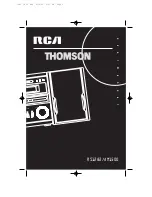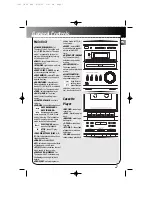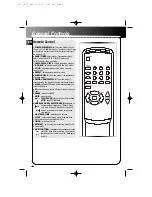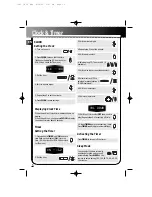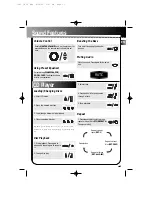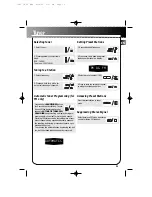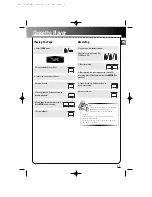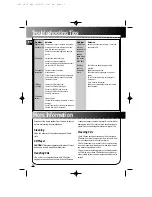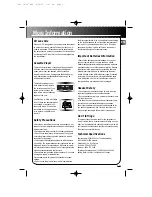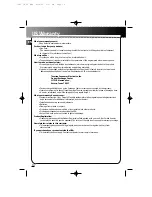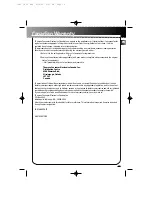
13
More Information
CD Lens Care
When your CD lens gets dirty it can also cause the system
to output poor sound quality. To clean the lens you will
need to purchase a CD lens cleaner which can maintain
the output sound quality of your system. For instructions
on cleaning the CD lens, refer to the ones accompanying
the lens cleaner.
Cassette Player
To prevent deterioration of sound quality, periodically
open the door of each deck and clean the magnetic
heads, pinch roller, and capstan with a cotton bud
dipped in alcohol. Also, demagnetize the head by play-
ing a demagnetizing cassette (available through an
audio equipment store).
To protect recordings one or
both sides of a tape, remove
the corresponding tab. If you
later want to record on the
tape, affix a piece of adhesive
tape over the hole.
Quit Slacking - A little bit of slack
in your tapes can cause scratches
on the tape, or worse yet, the
tape could break. If you notice
some slack in the tape, use a pen-
cil to tighten it up before you
insert it.
Safety Precautions
• Never open the cabinet under any circumstances. Any
repairs or internal adjustments should be made only by a
trained technician.
• Never operate this product with the cabinet removed.
• Do not touch the player with wet hands. If any liquid
enters the player cabinet, take the player to a trained
technician for inspection.
• This compact disc player uses a laser to read the music
on the disc. The laser mechanism corresponds to the car-
tridge and stylus of a record player. Although this prod-
uct incorporates a laser pick-up lens, it is completely safe
when operated according to directions.
• Discs rotate at high speed inside the player. Do not use
damaged, warped, or cracked discs.
Prevent damage to this product, set switch for proper
voltage.
• Do not touch the pick-up lens which is located inside
the disc compartment. Also, to keep dust from collecting
on the pick-up lens and do not leave the compartment
door open for an extended period of time. If the lens
becomes dirty, clean it with a soft brush, or use an air
blower brush designed for camera lenses.
Important Batteries Information
• Remove the batteries to avoid leakage if you do not
use your remote control for more than one month.
Discard leaky batteries immediately as leaking batteries
may cause skin burns or other personal injuries. Dispose
of batteries in the proper manner, according to provin-
cial and local regulations. Any battery may leak elec-
trolyte if mixed with a different battery type, if inserted
incorrectly, if all batteries are not replaced at the same
time, if disposed of in fire, or if an attempt is made to
charge a battery not intended to be recharged.
Headset Safety
• Do not play your headset at a high volume. Hearing
experts are against continuous extended play.
• If you experience a ringing in your ears, reduce volume
or discontinue use it.
• You should use be extreme caution or temporarily dis-
continue use it in potentially hazardous situations.
Even if your headset is an open-air type designed to let
you hear outside sounds, don’t turn up the volume so
high that you are unable to hear what is around you.
Don’t Infringe
This product should only be used for the purposes for
which it is sold, that is, entertainment, violating no copy-
right law. Any attempts to use this product for which it is
not intended is unlawful and therefore not condoned by
Thomson Consumer Electronics.
Technical Specifications
Power supply: 230V~50Hz for Thomson models,
120V~60Hz for RCA models.
Dimensions ( H x W x D mm):
Unit size - 329 x 307 x 360
Speaker - 246 x 170 x 195
CD player: Response curve (+/- 2dB): 20Hz to 20 kHz
Rating Plate: Look for it at the back of the set.
EN
A
Side A Protection
B
Side B Protection
A
1282 IB US ENG 4/24/00 3:47 PM Page 17

